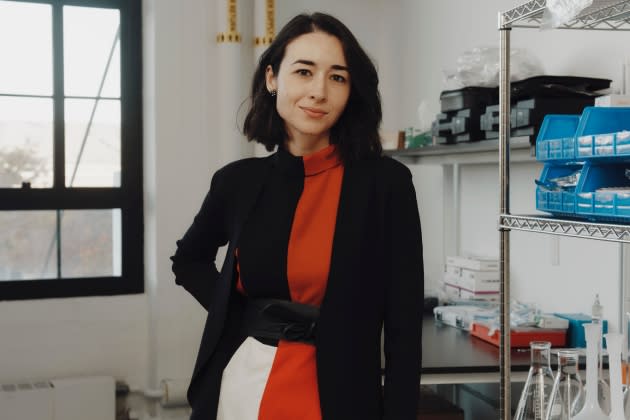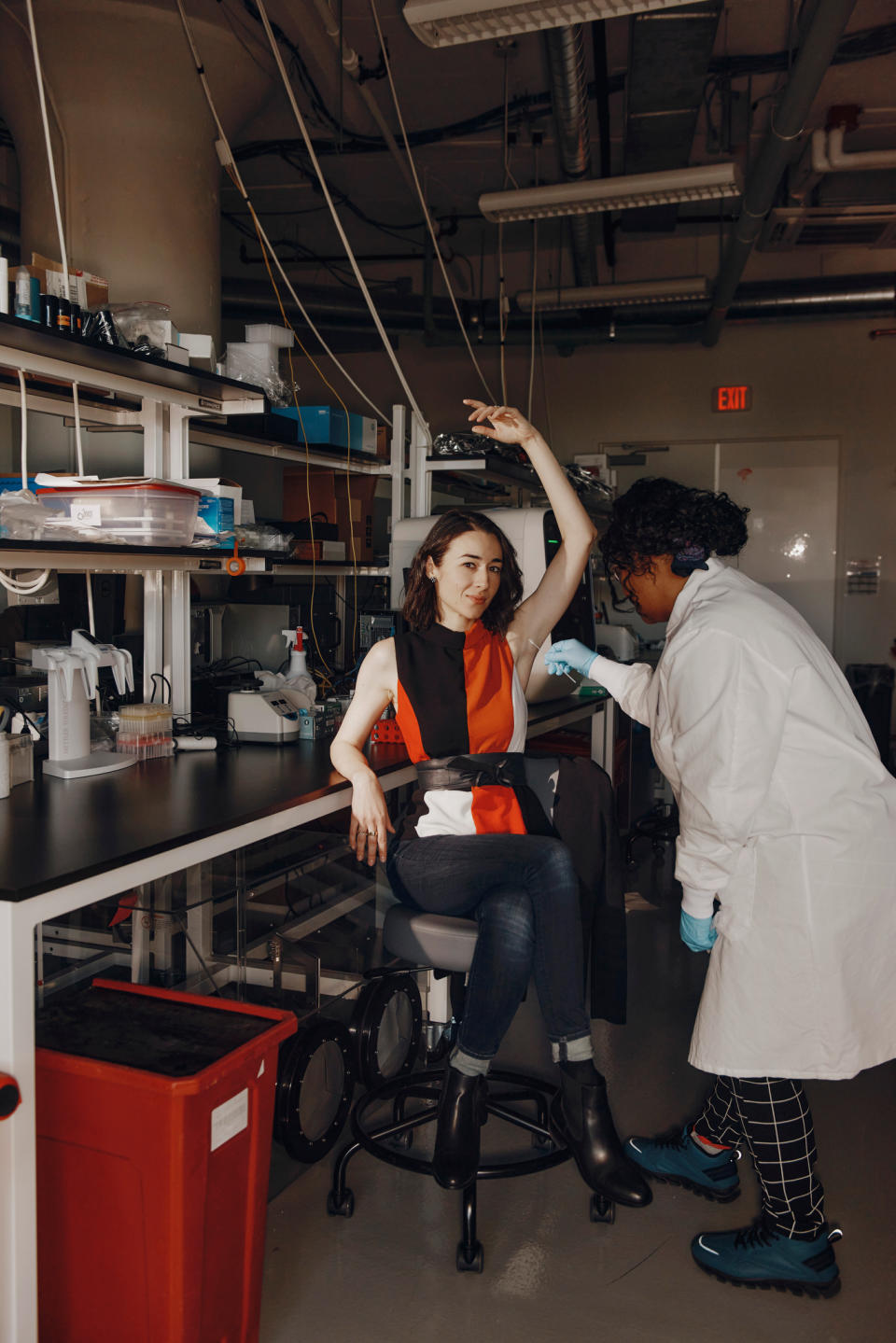Experience Matters With Jasmina Aganovic

When thinking about beauty products, phones and cars, especially Teslas, aren’t usually top of mind. Unless you’re Jasmina Aganovic that is.
“Future beauty products are going to be less about the establishment or the reinforcement of a beauty ideal,” said the Arcaea founder and chief executive officer. “We need to expect the same levels of performance and sophistication from our skin care and beauty products as we do frankly right now from our cars and our phones. What’s going on with electric vehicles is pretty incredible.”
More from WWD
With her start-up, which raised an impressive $78 million in Series A Funding from investors including Chanel, Givaudan and Olaplex during the COVID-19 global pandemic, the MIT grad is using biology to make beauty products of the future more about individualism and consumers getting to know their bodies.
Think deodorants that feed certain microbes in that ecosystem so that they don’t produce smelly compounds instead of just masking the smell with chemicals and proteins that can change the shape of hair in place of damaging heat styling tools.

The list goes on, with Arcaea using DNA sequencing, biological engineering and fermentation in order to develop these new beauty ingredients and products with the goal of creating a new supply chain for beauty that doesn’t rely on petrochemicals or depleting natural resources, like plants and animals.
“Some of the challenges that we’ve been learning over the last decade is that the way that we have been sourcing things and building things and constructing things is not sustainable,” Aganovic said.
Recently, the entrepreneur sat down with Beauty Inc to discuss her career, which includes stints at Fresh and Living Proof as well as her start up Mother Dirt, and plans for Arcaea.
How did you develop your interest in science?
Jasmina Aganovic: I always had a predisposition to an engineering mind-set and building things. Then, as a kid, especially a teenager, my hair was super frizzy and I was dealing with acne. That really ended up introducing me to the industry in the first big way. And it wasn’t just about using the products, it was understanding how they worked. That got me interested in chemistry, but I never thought I would end up in [the beauty] industry. That was a serendipitous outcome toward the end of my time in college. I went to MIT, studied engineering, specifically chemical and biological engineering, and then my senior year actually made the decision to go into beauty and personal care innovation.
What drove that decision?
J.A.: I was doing an internship at a small investment firm that was working with early technologies coming out of Harvard and MIT labs. The reason I was there was because I just really knew I liked doing things that would show up in the world through science. I got this project to review some beauty research that was coming out of this lab at MIT and it was given to me because I was the only woman at the firm and, frankly, I was really annoyed because I was like “This is a terrible reason to give someone a project,” but it was definitely a big epiphany for me. As I was going through that research, I realized how aligned it was with my background and what I enjoyed learning and also with an industry that I really loved. That’s when I was like, I could do this.
What made you decide to start your own company?
J.A.: When I was working at Living Proof, I had an opportunity to be on QVC and interact with Sephora, going to several of their locations across the mid-Atlantic region. I became so interested in how innovation is translated, how things from the lab show up in the products that people are using, and that led me to become very curious about the interplay between marketing and sales and innovation, which led to a series of leadership roles. Through those roles, I ultimately developed my point of view of what was missing in the industry, and that ultimately led to founding a few companies and, of course, now Arcaea.
How was the fundraising process? Had you ever done anything like that before?
J.A.: The answer’s no. I think there were a lot of things that were very unusual about the fundraising process. First and foremost, we started fundraising literally the week before the world closed down for the pandemic. The series A needed to take place virtually during this incredible time of uncertainty. It was scary, for sure. I remember when the pandemic started having this sinking feeling in the pit of my stomach that this idea that I wanted to create was so close. And yet now this opportunity to make it a reality was going to slip away because of this horrific thing that was happening in the world. Strangely, that wasn’t what happened. Because of the things that were happening in the world, many investors were realizing that the way that we were doing things was not going to be enough to get us to the type of future that we wanted to see. Instead of people becoming kind of scared and pulling back, people turned to companies, entrepreneurs, arts, creativity, all these different places, to see more of what they wanted to see in the future.
Do you have any mentors?
J.A.: My dad was a big part of this and continues to be. I’m first generation American so I grew up around immigrants who came to this country with nothing and managed to give us everything and so their perspective around believing that your future is boundless and unlimited was something that shaped me a lot. Through school, my lab supervisor taught me a lot about deliberate thinking and being thoughtful and methodical. I’m still in touch with him to this day. From the beauty industry, I’ve met so many great people. Pamela Baxter — I was just coming out of school so it was pretty amazing to meet her several years ago and she’s been just a wealth of knowledge. Katia Beauchamp — I got a chance to meet her a few years ago and I followed her career and have been so greatly inspired by the game changer that Birchbox is and what it created across multiple industries.
What are the formative career moments that really impacted you?
J.A.: When I was at Living Proof everyone was wearing multiple hats and I had joined to be on the R&D team. The next thing I knew, they were training me to be on QVC. It was a game-changing moment for me. It was real time feedback in a very intense way, because I would be saying something and [the producer] would immediately be telling me if it was working. They would say, “OK, stop talking about XYZ, that’s not working. What is working is this other stuff.” This was a watershed moment, because I started to realize that translating science and innovation in a resonant way is really challenging and actually a puzzle I love to solve.
The other one was during my time at Mother Dirt, which was one of the first brands in the skin microbiome space. The guidance we were getting from the industry was to take this amazing technology but to chisel off pieces of it, so it could fit into the formulation stack of chemistry. I actually thought that doing the inverse was more interesting, trying to figure out how to build more tools so that an incredible technology like biology could exist and exert its full power.
What’s your vision for the company?
J.A.: My vision for the company is the ability to make biology the most desired part of any product that we use.
Where do you see the ingredient space in beauty in 10 years?
J.A.: At Arcaea, we talk a lot about expressive biology — ingredient technologies that allow us to harness our own biology as a tool of self-expression. In the deodorant space, if you historically look at how the industry has managed body odor, it’s either been about blocking your sweating or your sweat glands, or it’s been about just killing everything that exists there. Or it’s been about masking scent. But with biology, we look at a problem like body odor, and we realize that it’s really about specific microbes that are making these smelly compounds. So, one of the programs we’re looking at is actually how can we design nutrients to selectively feed certain microbes in that ecosystem so that they don’t produce those smelly compounds. Another example of what we’re working on is in the hair care space. With biology, we can actually work with the keratin proteins inside your hair.
Would you ever see yourself coming out with a product line or turning into a brand incubator or do you just see your path as an ingredient supplier?
J.A.: We are doing both. We will be selling our ingredients into the industry and we are also going to be launching brands of our own. The reason we’re doing this has a lot to do with the incredible influence that brands and brand stories can have on shaping awareness for new space like biology.
John Melo from Amyris said he moved into creating his own brands because it was difficult sometimes to get the big companies to use these alternative sources so he decided to just go straight to the consumer.
J.A.: I think adoption is always something that a new technology is going to be facing and sometimes it’s hard for us to see how new technologies can show up in the world. That goes back to the point I was making earlier about the power of a brand to tell a story in a new space. Brands can establish and shape categories. Look at what Olaplex did for the bond building category. If that technology had been introduced to the ingredient space, it would not have had nearly the massive ripple effect that Olaplex has had as a category leader and founder in that space. Brands are really important.
With your science, would you ever think about entering any other categories other than beauty?
J.A.: We are focused on beauty and personal care, so you’ll see things like skin care, hair care and body care coming out of our innovation platforms. We’re not currently planning to go into anything ingestible or beyond that. But who knows? We’re building a pretty robust set of core competencies and series of technical platforms so in the future that might change, but right now we’re focused on what’s ahead of us.

